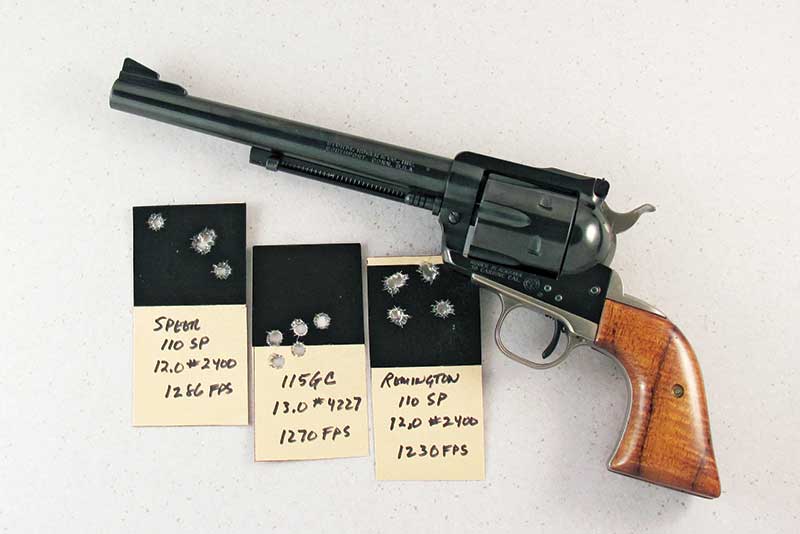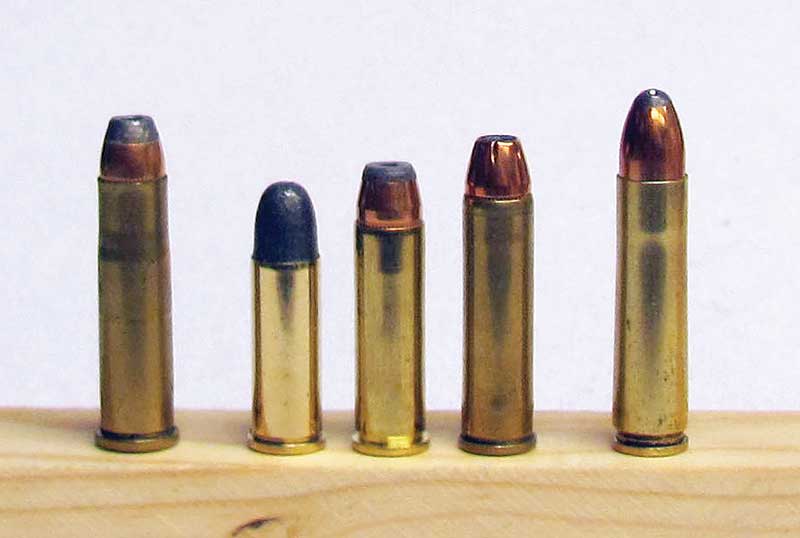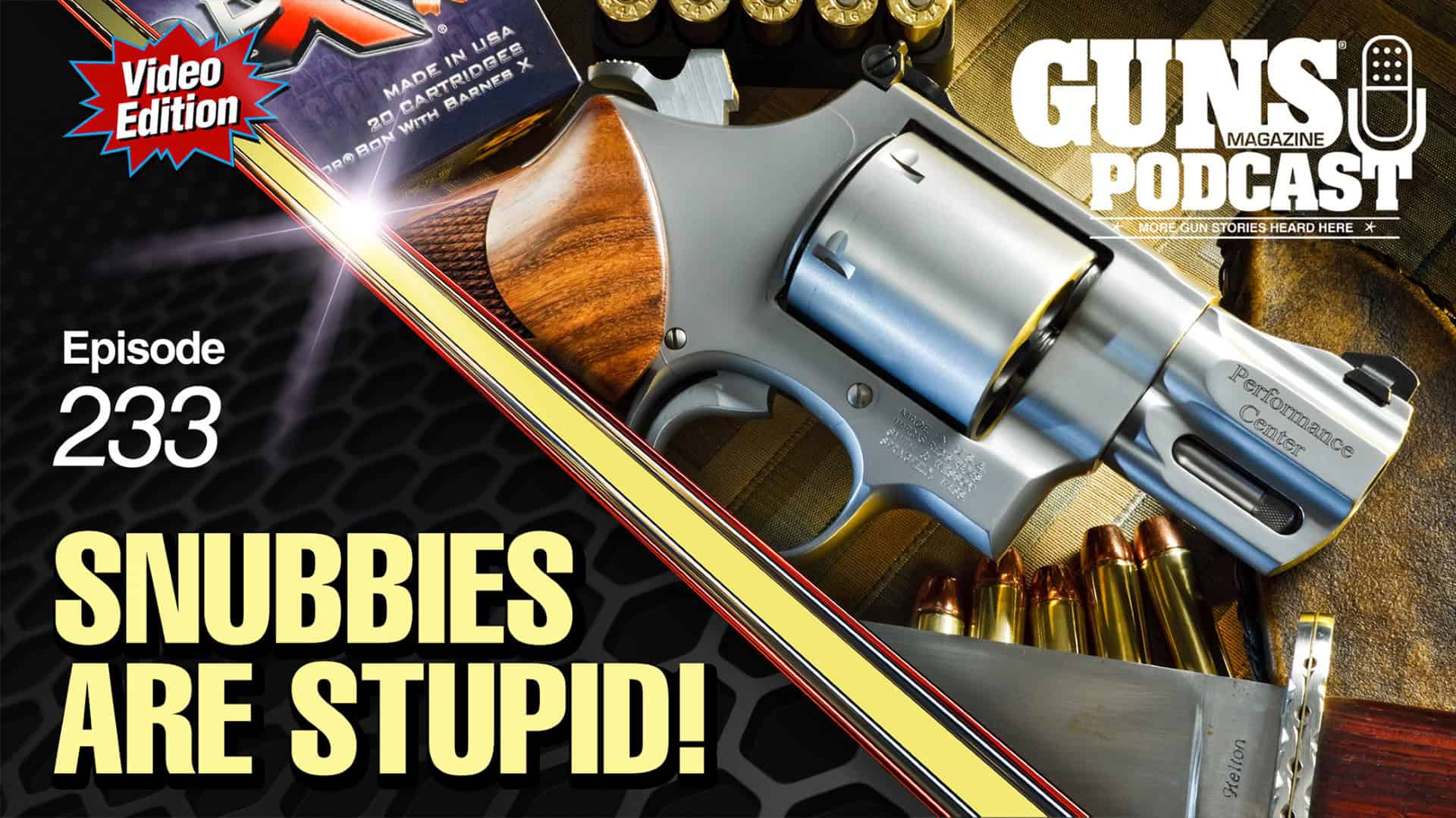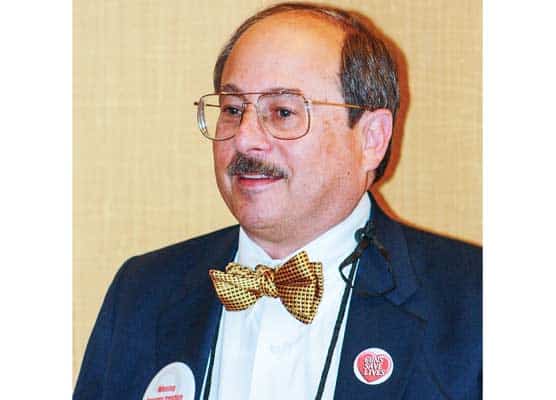Small Bore, Big Results
The .30 Carbine makes a surprisingly
effective revolver round

With proper loads the Ruger .30 Carbine Blackhawk will shoot as accurately as any other chambering. The Ruger Old Model .30 Carbine is only safe to carry when loaded with five rounds. The only version Ruger has ever offered is the standard model with a 7-1/2-inch barrel (custom stocks are by Keith Brown).
The M1 Garand and M1 Carbine were the main weapons used by GIs in WWII and Korea. By the time of Vietnam, both guns were considered obsolete, and the military went with the M16. Suddenly the market was flooded with .30 Carbine surplus ammunition. This ammunition could be purchased at very reasonable prices whether you wanted a single round or a case or anything in between.
Bill Ruger saw a niche in the market and in 1968 began offering the Blackhawk in .30 Carbine. This little cartridge was chambered in a sixgun built on the Super Blackhawk-sized mainframe. At first, both the Old Model and the New Model were only offered in one version, namely a 6-shot, 7-1/2-inch barreled sixgun with the standard XR3-RED grip frame.
Anytime I have seen something that really interested me in magazines, I have clipped it and saved it. First I went with file cabinets, and then, as they became available, I started using protective plastic sheets and large 3-ring notebooks. To date, my file of information consist of over 120 such notebooks, containing all of my articles as well as those from others. One of these “saves” goes back to the early 1950’s from the American Rifleman. The piece entitled “Pacific Island Dream” tells of a soldier’s desire to build a .30 Carbine sixgun when the war was over and he was back home. He accomplished this using a Colt Bisley Model with a 7-1/2-inch barrel and custom adjustable sights. Fifteen years later, Ruger made it possible for anyone to have a .30 Carbine sixgun at a very reasonable price.
The .30 Carbine built on the Super Blackhawk-size frame struck me as being overly heavy (I still had a lot to learn!). Plus, just whom were they trying to fool? Semi-automatic cartridges didn’t belong in sixguns. Did they? That is why cartridges have rims so they can be used in sixguns. This thought changed just a few years later when I found a Ruger .45 Blackhawk with a second cylinder in .45 ACP while attending graduate school. I soon learned just how well semi-automatic cartridges actually worked in sixguns, especially single-action sixguns. But for the time being, I was blissfully ignorant. I was totally happy to go along my way and probably would have completely ignored the .30 Carbine sixgun forever.
And then one of those meant-to-be things happened. My shooting and hunting partner, who also served as the photographer when pictures of me were needed, called one quiet evening and said, “You’ll never guess what I just bought.” Yes, it was, it really was a .30 Carbine Blackhawk. I just picked up a 3-screw .30 Blackhawk for $150. Of course, he had to bring it over. Even though the bluing was well worn, it locked up tight and showed no signs of abuse. Apparently, it had been carried a lot and everyone had passed it up because of the worn finish. The store lowered the price until it finally sold.
“I figured you would want to try it out so I ordered a set of Lee dies with the taper crimp die and 500 rounds of Remington brass, which will be here next week,” he teased. To top it off, he brought it over with a 2X Leupold scope mounted. What more could I ask for? I was ready for a break from the heavy kickers. A heavy sixgun with no recoil and a scope to help me shoot it without straining my eyes was dropped right into my lap.
The .30 M1 Carbine was a product of World War II, designed to take the place of the .45 Government Model, as it would be easier to fire accurately for many GIs. It was primarily offered to those in support roles. Christy Gun Works offered .30 Carbine replacement barrels and cylinders for the Colt Single Action Army, and the former soldier, mentioned above, serving in the Pacific, had his Bisley Model converted to .30 Carbine by Christy with the frame-mounted firing pin to handle high pressure.
Other companies had tried to build a .30 Carbine handgun, but it remained for Bill Ruger to bring out the first successful one. It did not take me long to learn to appreciate the .30 Carbine Blackhawk, and I asked Joe if he wanted to sell it. He didn’t. The combination of almost non-existent recoil with excellent accuracy makes the .30 Blackhawk a real pleasurable sixgun to say the least.
All that glitters is not necessarily gold, and special care has to be taken with the .30 Carbine. Since it is a rimless cartridge, it must have space on the front of the case mouth in the Ruger cylinder. This means no traditional crimp on the bullet, which can be a problem in a revolver. In this case, recoil is not enough to cause a bullet in the neighboring cases to jump forward. However, the crimp is usually necessary to get the powder burning properly. The answer to the latter problem is a taper crimp die, which puts a long, firm pull on the bullet in the loaded brass. It is also necessary for the best accuracy.
Other than the necessity of a fourth die for best utilizing the taper crimping operation, the .30 Carbine reloads as easily as a standard straight-walled sixgun cartridge. The .30 Carbine is sure to be compared to the .32-20. The .32-20 has an all-important rim, which allows bullets to be crimped for use in sixguns, but the .30 Carbine is much stronger brass. The necks of .32-20 brass were lost with regularity until Starline brass solved the problem. This has never been a problem with the .30 Carbine brass. It is as tough as the other magnum sixgun cartridges. Some have converted .30 Carbine Blackhawks to .32-20 and while it works, it does not work well. The diameter of the .32-20 is big where the .30 Carbine is little, and vice versa.
I wound up loading and shooting 400 rounds through Joe’s .30 Blackhawk, and it was such a pleasant experience I soon found not one, but two Old Model .30 Carbine Blackhawks at very reasonable prices in excellent shape. From the time they were first introduced nearly 50 years ago, the .30 Carbine Blackhawk has not been a large seller, but it has been a steady selling sixgun and is still carried in the catalog today.
Even though they are only about a year apart in production, my two .30 Blackhawks are quite different. One cylinder will accept loads the other will not, while one cylinder allows some factory .30 Carbine loads to move forward when the hammer strikes the primer, resulting in misfires. The .30 Carbine uses bullets properly sized to 0.308-inch, and Speer offers both a 100- and 110-grain jacketed bullet in this diameter, while Remington offers a softpoint with the latter weight. I also had some military 110-grain FMJ’s to work with.
There are other bullets probably available, but, as I write this, we are still in the middle of shortages of about everything related to shooting. The bullets I had on hand included the standard Lyman 311316GC .32-20 bullet sized to 0.308 inch. I have found four loads which will group 5 shots into 1 inch at 20 yards in my .30 Carbine Blackhawks. Those loads are the Speer 100-grain Plinker over 14.5 grains of H110 with a muzzle velocity of 1,360 fps; the same Speer 100-grain SP with 13.0 grains of AA9 for 1,400 fps; the Remington 110-grain JSP delivered 1,230 fps, using 12.0 grains of 2400, and the Lyman 311316GC 120-grain cast bullet with 11.0 grains of 2400 gave 1,400 fps. The Lyman bullet with 13.0 grains of 4227 is also accurate at a slightly milder 1,270 fps. My most accurate load is the Speer 110 SP over 14.5 grains of H4227 for 1,263 fps and a 3/4-inch group.
Any of these mentioned loads are accurate enough and certainly powerful enough to be used for varmints or small game shooting, however, by no stretch of the imagination should the .30 Carbine be considered for big game. These loads are certainly safe for use in the M1 Carbine, but I won’t guarantee they’ll cycle as they were worked up for accuracy in my sixguns. It is well below the .357 Magnum, which is marginal at best for anything much larger than deer. The .30 Carbine should be considered for the small critters mentioned as well as plinking and short-range silhouetting.





